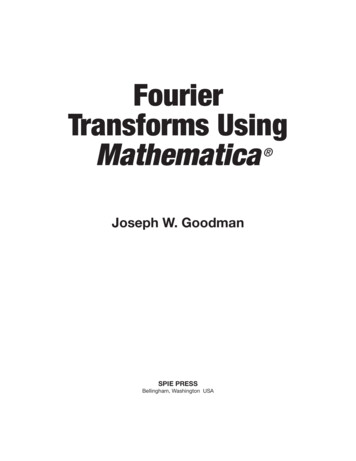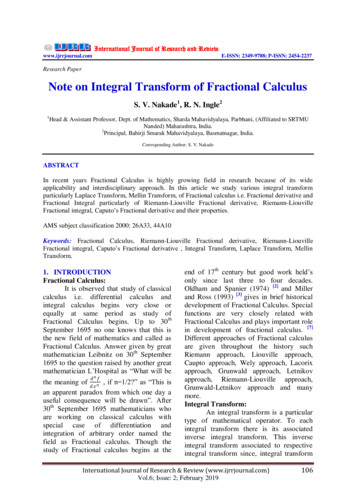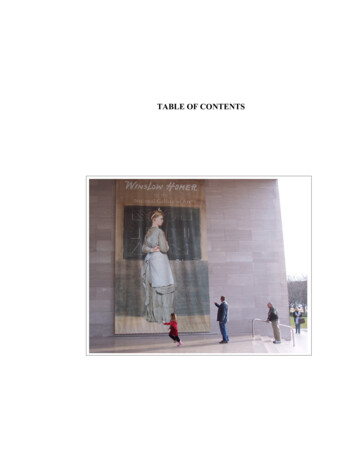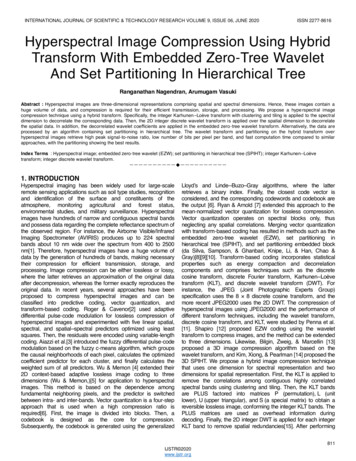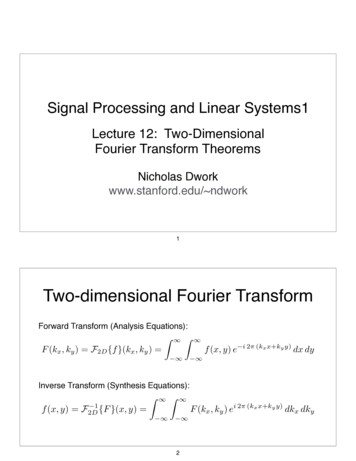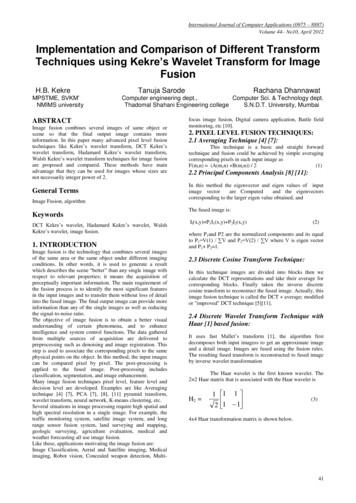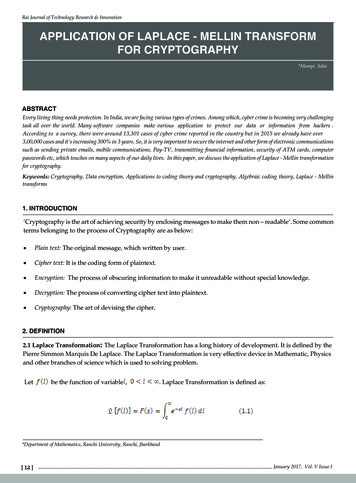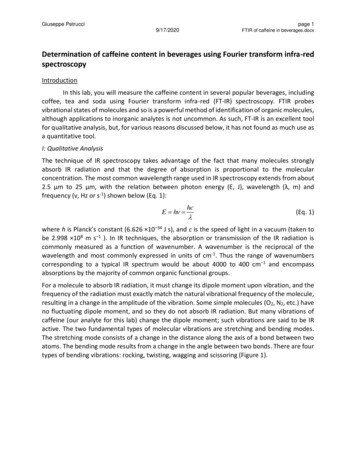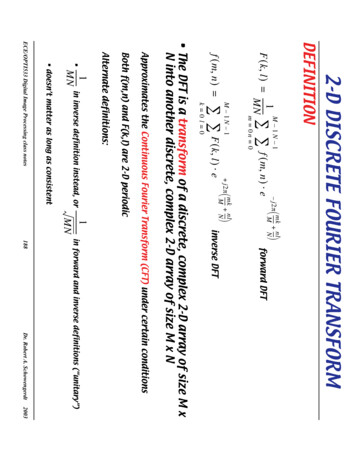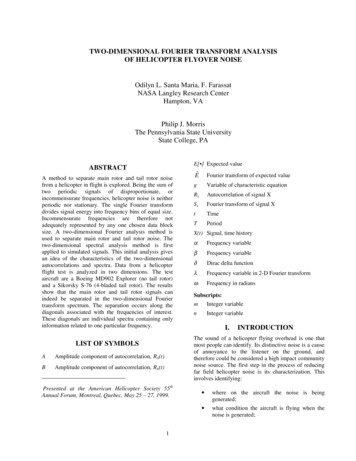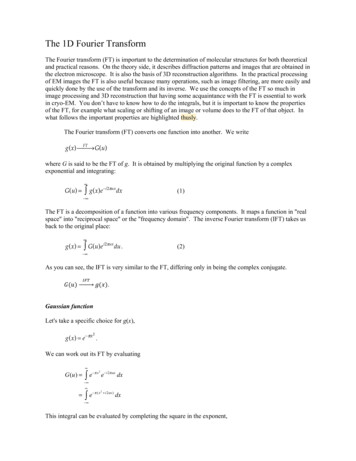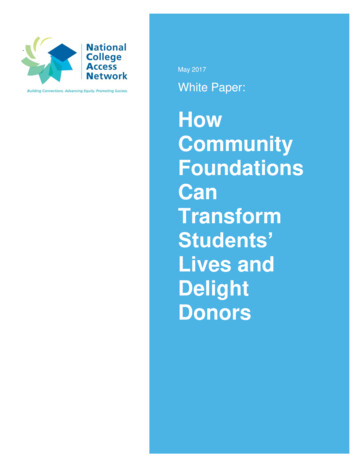
Transcription
May 2017White ��Lives andDelightDonors
Writers:Colette Hadley, Director of Consulting ServicesElizabeth Morgan, Director of External Relations 2017 National College Access Network. All rights reserved.Washington, DCwww.collegeaccess.org
The Surprising Way Community FoundationsCan Transform Students’ Lives and Delight DonorsCommunity foundations have a lot of competition for donors these days. Growth incommercial donor-advised products such as the Fidelity Charitable Gift Fund hasexploded, and even churches, universities, and United Way chapters have developedtheir own donor-advised fund options. As a result, many community foundations areworking hard to distinguish themselves from the pack in order to retain and attract newdonors.Research from the Center for Effective Philanthropy (CEP) finds that donors believe thetop two advantages of working with a community foundation are personal service anddemonstrable impact in the local community. Unfortunately, CEP also found that impactoften takes a back seat to donors’ perceived interests: “The competition for donorresources has led some community foundation CEOs to focus on being responsive todonor interests and needs in a way that undermines the foundation’s ability to workstrategically. The focus on the donors becomes an end in itself, rather than a means tocommunity impact.”So how can community foundations break the pattern of over-responsiveness to donorsand significantly increase impact? We have one surprising word for you: scholarships.The easiest and most effective way for foundations to demonstrate measurable impactin their community and to attract donors is to transform their scholarship programs as apart of a strategic postsecondary attainment initiative.Educational causes rank as the second-most popular charitable giving choice for U.S.individuals and family foundations (religion is number one). Many education donorsdirect their gifts to postsecondary causes like scholarships, especially at private K-12schools and universities. Thus, one would think that community foundations would bedoing everything they could to strategize and market their scholarship programs todonors. But in most instances the opposite is true. A large number of CEOs atcommunity foundations push their scholarship programs to the periphery. Developmentofficers work with scholarship donors in a passive manner and do not integrate thesedonors into the foundation’s larger initiatives. Many foundation staff members simplyview scholarship programs as an administrative burden to bear, not an asset to improveand expand.In fact, most foundations fail to channel these scholarship dollars strategically to supportlow-income students who otherwise would not complete postsecondary education.Many scholarships housed at community foundations and private funders are meritbased, in effect serving as a well-deserved reward for students who have excelled inhigh school — regardless of whether they have significant financial need. Compoundingthe problem, in almost every case scholarships are small dollar amounts, nonrenewable, and lack support services that many students need to stay on track tograduation. Unfortunately, fear of offending or driving away contributors makes manyCEOs unwilling to discuss these shortcomings.Page 3
In the same communities, nonprofit college access organizations and higher educationinstitutions help motivated, low-income students prepare for, enter, and completepostsecondary education, but they often have no relationship with their local communityfoundation. Research shows that need-based scholarships coupled with supportservices providing academic and financial aid counseling greatly boost postsecondaryenrollment among low-income students, providing incentives that contribute to studentpersistence and success.At the National College Access Network, we find that foundations that undertake ascholarship program assessment are often surprised to find that donors respondpositively and enthusiastically to the prospect of making greater impact with their gifts.Community foundations can still maintain a boutique, donor-driven scholarship programfor those who want it, while expanding their educational initiative to include strategic,need-based scholarship awards within the same administrative structure.For example, the Kern Community Foundation in Bakersfield, CA has managed donorcriteria scholarship funds for a number of years, but has recently expanded theirscholarship program to embrace a regional postsecondary completion initiative called“Kern Futures” for low-income and underrepresented students. At the same time, Kerndesigned a new menu of giving opportunities for interested scholarship donors, makingseveral attractive entry points for donors to get involved. Scholarship contributions areon the rise – up 20 percent in just the first year of the initiative.Forming the Kern Futures alliance with college access programs, school districts, andlocal higher education institutions has allowed the Kern Community Foundation toleverage its scholarship dollars with support services and data collection provided bythese partners. In turn, new donors have been attracted to the initiative because of itstwin goals of providing educational opportunity, and increasing the number ofpostsecondary graduates who meet local workforce needs.Community foundations need assistance in understanding how to reach maximumeffectiveness and impact with their scholarship funds. In our experience, mostfoundations:1. Have yet to understand the true student needs and workforce needs in theirregion. Benchmarking against other local, state, or national rates of high schoolgraduation, postsecondary enrollment at two-year and four-year colleges,enrollment in remedial classes, and postsecondary degree completion for lowincome and underrepresented students is crucial. In addition, foundations shouldbe aware of the fastest growing areas of employment in their community andwhich degrees or credentials are needed to fill those jobs. Local employers areoften a good source of donors. What are you doing to help them with theworkforce skills gap?2. Must work on transitioning their scholarship programs from being completelydonor-driven to being driven by the regional goals. Each piece needs to beassessed – from the policies, processes, and technology used to manage thescholarship program, to partnerships with support service providers, to themanner in which award recipients apply, are selected, receive scholarshipPage 4
payments, and are tracked. All of these items are vital when striving to increaselevels of postsecondary attainment.3. Are reluctant to educate and inform their current and prospective donors aboutwhat can be done to increase postsecondary attainment and why it matters, andabout the opportunity to invest in local talent. Community foundations generallyexcel at accommodating donors, and particularly in the area of scholarshipdonors, most foundations are very willing to accept all sorts of scholarshipselection criteria in order to land a donor. But to truly make impact, foundationshave a responsibility to do better at educating their donors with a proactive effort,not a reactive one. Donors are hungry for knowledge and want their giving tomake a big difference.4. Haven’t learned how to measure and report the impact of their scholarshipprogram. Right now, many foundations across the country cannot produce anymeaningful data on their scholarship recipients. Did those recipients completeone year of postsecondary education in good standing? Did the award amountmake a significant impact to keep the student enrolled? How many recipientshave completed postsecondary education? What is their attrition rate and why?These types of basic data points are critical to transforming a program and toattracting and retaining donors.Community foundations that have recognized these elements and implementedassessments and revisions are finding success. One example is the StanislausCommunity Foundation (SCF) in Modesto, CA. Established in 2002, SCF was designedwith a traditional community foundation structure that included a donor-drivenscholarship program. The Stanislaus region is located at the northern end of California’sCentral Valley, dominated by a large agricultural industry and many small rural farmingcommunities. Only one in six Stanislaus residents aged 25 or older has a bachelor’sdegree or higher, compared with one in four across all of California.SCF recognized that its criteria-heavy scholarship funds program was not makingimpact for low-income youth or helping to drive postsecondary attainment in the region.So staff regrouped and embraced an assessment and new approach for theirscholarship program, aimed squarely at increasing postsecondary degree completionfor low-income students. The new initiative links SCF’s scholarship program to sixschool districts and two higher education institutions as service partners. Thesepartners provide a broad array of postsecondary access and success activities to lowincome scholarship applicants to ensure recipients are successful in earning acredential or college degree. Stanislaus has already doubled the number of contactsfrom interested contributors, and is working with regional media partners to reach out toeven more potential donors.In general, postsecondary completion initiatives have been proven to be broadly popularand supported by people of all backgrounds and political ideologies across the nation.Educational equity issues are widely understood, have a moral urgency, and areattractive to potential contributors.Page 5
Based on NCAN’s work with dozens of cities across the nation on increasingpostsecondary degree and credential attainment, we recommend the following steps forcommunity foundations: An assessment of the foundation’s current program. How are scholarshipscurrently marketed to applicants and processed? Are best practices being used?Are there barriers to low-income students?A survey of potential partners in your city. Is the community foundation aware ofwhich programs exist, what services are provided, how many studentsparticipate, and what the outcomes are for these programs?A look at strategic scholarship management. How is financial need determined,and what role does it play in relation to award amounts? What committees orvolunteers are involved in scholarship selection? How are scoring rubrics orevaluations developed?Incorporating data collection and benchmarking in a standardized way. Whatdata do the community foundation need, how can it be collected painlessly, andwhat are the right benchmarks for comparison? Most importantly, how does thefoundation demonstrate that its scholarship program is making a difference forstudents?Learning more about how to educate and enlist donors, what to do with selectioncriteria funds with heavy administrative burdens, the pros and cons of endowedfunds versus annual funds, and ways to retain and renew donors.In their quest to improve strategies, infrastructure, and processes, communityfoundations need not be stuck with outdated scholarship programs. With some researchand redesign, foundations can transform these programs into assets that measurablyhelp students and the local workforce as well as attract more local individuals andfamilies into the donor pipeline.Since 1995, the National College Access Network has been dedicated to building,strengthening, and empowering communities committed to college access and successso that all students, especially those underrepresented in postsecondary education, canachieve their educational dreams.Page 6
For example, the Kern Community Foundation in Bakersfield, CA has managed donor-criteria scholarship funds for a number of years, but has recently expanded their scholarship program to embrace a regional postsecondary completion initiative called "Kern Futures" for low-income and underrepresented students. At the same time, Kern
